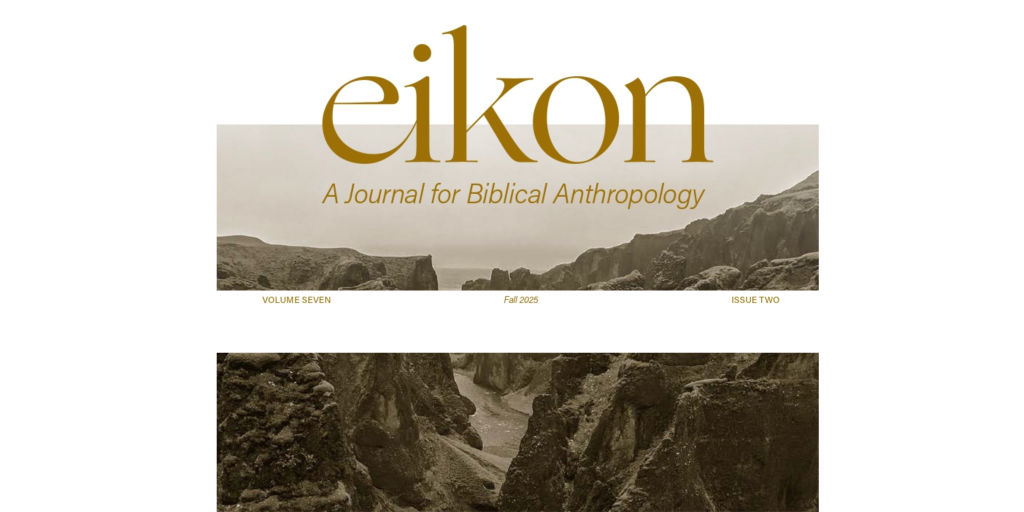
Editor’s Note: The following forum contribution appears in the Fall 2025 issue of Eikon.
God’s determination to make mankind in his image introduces the climactic creative act in the creation account of Genesis 1. That mankind would be so characterized, both in the declaration of divine intent of verse 26 and in the statement of their creation in verse 27, suggests its importance for an understanding of human identity and purpose. Unsurprisingly, the concept of the image of God has become a central one for theological anthropology, being appealed to in support of human dignity and equality.
The primary sense of the image of God is that of mankind as an appointed authority and symbol of God’s own rule, a sense more clearly seen in the blessing and commission of verse 28: mankind is to engage in transformative labour in the creation, taming and ordering it, filling and glorifying it, bringing it under his sway and representing God’s authority within and over it. In this, mankind would follow the pattern of God’s own creative labour, by which he formed and filled the world. Man would also come to act on earth in a manner comparable to the divine council in heaven, within which angelic beings serve as priests of the heavenly temple, as king-like powers and authorities, and as prophetic council members and bearers of the word of the Lord.
There is a threefold parallelism in Genesis 1:27:
- 1) God created 2) man 3) in his image
- 3) in the image of God 1) he created 2) him
- 3) male and female 1) he created 2) them
This is not mere repetition: it discloses something of the multifaceted character of humanity. Man is first spoken of as a singular entity (“him”) and then as a plurality (“them”). Humanity is a kind, a race, and a host. The unity of humanity is seen in the representative figure of Adam, who as the first and father of mankind can stand for all: in him humanity as a kind is seen. Humanity is also a race, expanding generation after generation into a multitude of families from the union of the first pair.
Mankind is created male and female. The duality and polarity of male and female is part of what constitutes the image — mankind is created with two halves or two sides that are counterparts of each other. This duality is not mere diversity, difference, or even sociality as such, but the specific mutually implicating and procreative disjunction at the heart of humanity. No other human difference has quite this character. The male and femaleness of humanity is essential for the fruitfulness with which humanity is blessed. Likewise, the broader human vocation is one that is characterized everywhere by the fruitful interplay of the differences between the sexes, not merely between married pairs but across humanity more generally.
A filial sense to the image of God might be hinted at in Genesis 5:3, within which Adam fathers Seth “in his own likeness, after his image.” To be created in the image of God is in some sense to be a “son of God.” While this sense of the image of God has implications for every human being (e.g. Gen 9:6), its meaning comes to more focused manifestation as figures like David are elevated to the exercise of royal authority (2 Sam 7:14). David expresses this exalted place given to man in Psalm 8:3–6:
When I look at your heavens, the work of your fingers, the moon and the stars, which you have set in place, what is man that you are mindful of him, and the son of man that you care for him? Yet you have made him a little lower than the heavenly beings and crowned him with glory and honor. You have given him dominion over the works of your hands; you have put all things under his feet…
When the author of Hebrews takes up these verses in chapter 2 of his epistle, relating them to Christ, we see their meaning focused on Christ’s representative rule as the last Adam, and our participation in him. Christ, who is the Image of God (Col 1:15), is the archetype and ground of mankind’s image-bearing.
While the reality of mankind’s being created in the image of God is most clearly manifested in a figure like the king, it would be misleading to think that the king has a greater share in the image of God on that account. Rather, he re-presents and ministers something that is a common gift to all mankind. Something similar can be said about Paul’s claim that man “is the image and glory of God” in 1 Corinthians 11:7. While this seems more closely to associate men with the image of God, Paul’s point is that men more particularly symbolize and re-present this common standing of mankind to itself, not that they more fully possess it. The logic is akin to that of the gift of the Spirit to the whole body in the chapter that follows and the re-presentation of that one Gift in the manifold and variegated gifts of the Spirit: such gifts are not the measure of a person’s participation in the one Gift, which is the common possession of all members of the body, both collectively and severally.
When Paul speaks of the restoration of the image of God in Colossians 3:10, it is the unified body of the Church in which it primarily occurs. The restoration is social in character: as Christ is all in all, his grace overcomes all fleshly oppositions, his pattern of life unites everyone, and the body of the new humanity is deepened in the knowledge of God.
You can read the other contributions to this forum “On the Image of God” by clicking on the links below:
Forum: On the Image of God (Peter Gentry)
Share This Article



